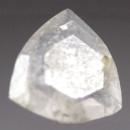|
|
||||||||||||||||
|
||||||||||||||||
|
||||||
|
|
|
|
Blödite
(Bloedite) |
|
| | |
| Discovered in 1821; IMA status: Valid (pre-IMA; Grandfathered) | ||
|
| ||
|
Chemistry |
|
|
| |
|
Na2Mg(SO4)2 • 4H2O | |
|
|
Hydrated Sodium Magnesium Sulfate |
|
Molecular Weight: |
334.47 gm |
|
Composition: |
Sodium |
13.75 % |
Na |
18.53 % |
Na2O |
|
|
Magnesium |
7.27 % |
Mg |
12.05 % |
MgO |
|
|
Hydrogen |
2.41 % |
H |
21.54 % |
H2O |
|
|
Sulfur |
19.17 % |
S |
47.87 % |
SO3 |
|
|
Oxygen |
57.40 % |
O |
|
|
|
|
|
100.00 % |
|
100.00 % |
= TOTAL OXIDE |
|
|
|
||||
|
Classification |
|
|
| |
|
Sulfates | |
|
6/C.18-10 | |
|
|
7 : SULFATES (selenates, tellurates, chromates, molybdates,
wolframates) |
|
Related to: |
Blödite Group. Blödite - Konyaite Series. |
|
Members of Group: |
Blödite Group: Blödite, Nickelblödite, Leonite, Mereiterite, Changoite |
|
Varieties: |
Natronkalisimonyit |
|
Synonyms: |
Astrachanite, Astrakanite, Astrakhanite |
|
|
|
|
Crystal Data |
|
|
|
|
|
Crystals equant to prismatic [001], with complex development, as with prominent {110}, {210}, {011}, {001}, {111}, {211}, and many others, to 10 cm; granular to compact massive. |
|
|
None |
|
|
|
|
|
Physical Properties |
|
|
|
|
|
None observed |
|
|
Conchoidal |
|
|
Brittle |
|
|
2.5 - 3.0 |
|
|
2.218 - 2.240 (g/cm3) |
|
|
None |
|
|
Not Radioactive |
|
|
|
Readily soluble in cold water. |
|
Optical Properties |
|
|
|
|
|
Colorless, may be dark Gray, Bluish Green, or Reddish from inclusions; Colorless in transmitted light |
|
|
Transparent to Translucent |
|
|
Vitreous |
|
|
1.483 - 1.487 Biaxial ( - ) |
|
|
0.0040 |
|
|
Relatively Strong |
|
|
None |
|
|
|
|
|
Occurances |
|
|
|
|
|
Geological Setting: |
In lacustrine salt deposits and salt efflorescences; probably a product of metamorphism of marine salt deposits; in nitrate deposits; may be a volcanic sublimate. |
|
Common Associations: |
Carnallite, Halite, Kainite, Polyhalite (marine salt deposits); Halite, Mirabilite, Thénardite (lacustrine salt deposits) |
|
Common Impurities: |
None |
|
Type Locality: |
Ischler Salzberg, Perneck, Bad Ischl, Upper Austria, Austria |
|
Year Discovered: |
1821 |
|
View mineral photos: | |
|
|
|
|
More Information |
|
|
|
|
|
| |
|
|
|
|
Blödite also forms as an efflorescence on cave and mine walls. An efflorescent mineral is one that forms as a precipitate from minerals in the air. Blödite crystals are very rare. Blödite crystals and gems should be stored in a sealed container to prevent them from drying out and crumbling. Possibly the only locality for gem quality crystals is Soda Lake, Carrizo Plain, San Luis Obispo County, California, USA. Blödite
is found in a limited number of localities worldwide.
The few notable localities are Willi Agatz Mine, Dresden, Saxony, Germany;
Astrakhan', Astrakhan' Oblast', Volga Region,
Russia; and Soda Lake, Carrizo Plain, San Luis Obispo County,
California, USA. |
|
|
We
have not photographed our Blödite gems
yet. Please
check back soon. |
